Home
Aussie Bee Online
Welcome
New Articles
About Native Bees
Bee Photo Gallery
Bees in Your Area
Common Questions
Rescuing Native Bees
Exotic Bumblebees
What are Stingless Bees?
Buying Stingless Bees
Honey Production
Crop Pollination
Study Native Bees
Field Guide
Information Booklets
Tim Heard's Book
John Klumpp's Book
Aussie Bee Back Issues
Seminars
Links
Support Native Bees
Aussie Bee Shop
Order Form
Who We Are
Donations
Privacy Policy
Free Newsletter
Website Survey
Download Printer-Friendly PDF version of this article
Native Bee Hives: Viewed in Spectacular 3D!
Dr Anne Dollin
Australian Native Bee Research Centre
December 2005
Mark Greco of the
University of Western Sydney - Hawkesbury has developed an amazing
new way of looking inside the nests of native bees, using 'X-ray
computerised tomography' or CT scans!
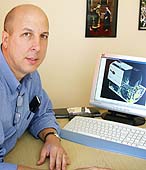 |
Our stingless
social native bees are secretive creatures! They enclose their brood
chamber inside an 'involucrum' sheath made up of multiple layers of
cerumen (a mixtureof wax and resin). If you break open a nest
frequently you will damage this vital involucrum sheath and bees may
drown in honey spilt into the hive. Curious beekeepers sometimes fit
glass observation panels to their stingless bee hives but stingless
bees quickly smear an opaque layer of resin over these panels.
Our solitary
native bees are also secretive. Many species hide their tiny brood
cells at the ends of narrow burrows in the soil. Breaking open a
solitary bee nest to observe it usually destroys the nest. So it is
normally very difficult to observe and monitor the progress of native
bee nests.
An
Innovative Solution
Mark Greco
has found a remarkable solution! Prior to beginning his PhD studies
at the University of Western Sydney, Mark had 25 years of experience
as a diagnostic radiographer. CT scans have been used for decades to
image the organs of patients for medical diagnosis. Mark decided to
try using CT scans to image the structures inside a hive of
Trigona carbonaria stingless bees. Macarthur Diagnostic
Imaging kindly donated time on their CT scanner for this project.
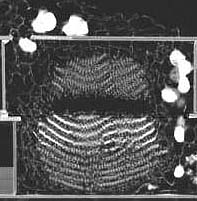 |
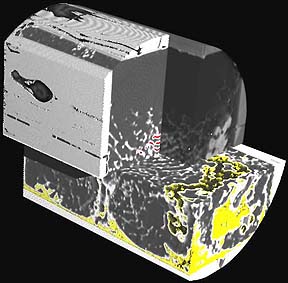 |
Mark did two
scans of the hive at right angles to one another. The CT computer
then combined the scans into dramatic three-dimensional images of the
inside of the hive.
The scans
accurately reveal the bees' intricate spiral brood comb. The layers
of larval cells in the brood can be distinguished from the layers of
cocoons. Clusters of pollen and honey pots can be seen around the
brood. The honey pots can be distinguished from the pollen pots
because the honey pots look brighter in the CT scan image. The CT
computer can also calculate accurate figures for the volume of the
brood and the volume of the honey and pollen pots.
Best of all,
this detailed information about the inside of the hive can be
obtained without harming the bees at all. Scientists have determined
the minimum radiation dose that has a biological effect in insects.
Mark says that the radiation dose needed to do one of his scans is
3,800 times lower than this minimum dose!
Monitoring Hive Health
Mark's new
technique allows scientists for the first time to take an accurate
look inside a hive of stingless native bees without opening the hive
up. A growing brood comb and increasing food stores are signs of a
healthy hive. So this technique allows scientists to monitor the
progress of a stingless bee hive at regular intervals during an
experiment without disturbing the bees.
'The queen
lays all her eggs in the brood chamber', says Mark, 'and if the brood
chamber is shrinking, then the queen is laying fewer eggs. If food
resources and environmental factors are adequate, then a shrinking
brood chamber can indicate that there are health problems within the
colony. A growing brood chamber indicates that the queen is laying
plenty of eggs and colony health is strong.'
Mark has been
using his CT scans to monitor the progress of stingless bee hives in
a greenhouse experiment. Mark is studying the potential of stingless
bees as pollinators of greenhouse capsicums. European honeybees
suffer when confined inside a greenhouse but Mark has found that the
greenhouse environment had no ill effect on the health of his
stingless bee hives. The progress of Mark's greenhouse study will be
reported in a future Aussie Bee Online article.
Scanning Solitary Bees Too
The nests of
blue banded bees can also be studied with Mark's CT scanning
technique. Blue banded bees dig nest burrows in clay soils and mud
bricks. It is impossible to examine a blue banded bee's nest tunnels
or brood cells without badly damaging the nest.
Mark scanned 13 of Melissa Bell's mud bricks containing blue banded bee nests (see Aussie Bee Online Article 2). The twisting tunnels and urn shaped brood cells of these solitary blue banded bees can be clearly traced in Mark's scans and developing larvae and pupae as well as fly parasites and invasive fungi can be seen inside many cells.
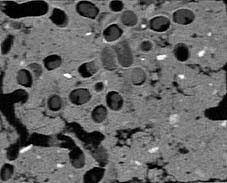 |
|
A two dimensional CT scan of a blue banded bee nest block, viewed from the top. Short lengths of nest tunnels can be seen as well as brood cells containing developing larvae and pupae.
|
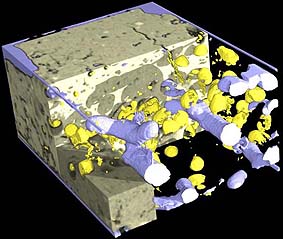 |
|
A three dimensional CT image of a blue banded bee nest block with part of the image cut away using computer software to reveal the internal structure of the block. Tunnels have been coloured in blue, brood cells in yellow and the mud brick material in beige.
|
With Mark
Greco's technique, the interior of native bee nests can at last be
seen in spectacular 3D without harming the bees. Many applications
are sure to be found for Mark's valuable new technique in research
projects on native bees throughout the world.
Further Reading
M Greco, R Spooner-Hart and Pl Holford (2005), A new technique for monitoring Trigona carbonaria nest contents, brood and activity using X-ray computerized tomography. Journal of Apicultural Research 44(3): 97–100.
Booklets in the Native Bees of Australia Series:
-- Nests of Australian Stingless Bees
These booklets are available from the Aussie Bee website:
https://www.aussiebee.com.au
or
contact the Australian Native Bee Research Centre,
PO Box 74,
North Richmond NSW 2754;
• Download
the PDF version of this article.
(If you have not used PDF
before, click
here.)
• For
more interesting Aussie Bee Online articles on native bees,
visit the contents
|
Please feel free to print out this article or to email copies of the PDF version to your friends. This article may also be reproduced or hosted on other websites providing it is kept in its full and unaltered form including ANBRC contact details.
|
.
Search Aussie Bee Website:
© 1997-2018 Australian Native Bee Research Centre
PO Box 74, North Richmond NSW 2754, Australia